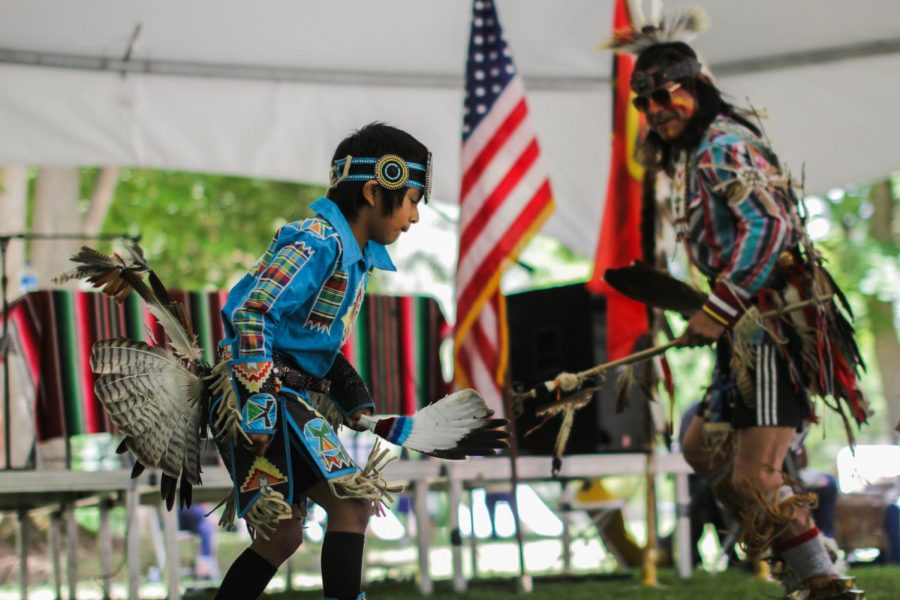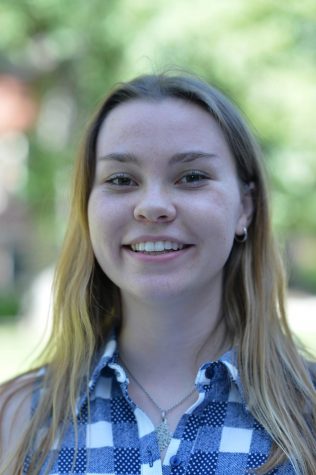Native man found connection in traditional dance
Powwow dances bring tribes, generations together, though styles change through time
RACHEL SUN | THE DAILY EVERGREEN
Teddy George Sr. dances alongside a young boy Saturday, May 18 near Lapwai, Idaho, for a Nez Perce cultural celebration.
July 3, 2019
Teddy George Sr. danced in circles to traditional drumming and pounded his feet, ankles wrapped in bells, at the 2nd Annual Nez Perce Culture Day last month.
He rode his bike from Lapwai, Idaho in his outfit to dance at the powwow. He was one of the older dancers, performing in his middle age. Children and teens lined up and danced in circles.
“They start them when they’re young so they can stay with it,” he said.
He encouraged his kids to dance from a young age. He remembers his grandfather, a chief, teaching him to dance when he was very young.
Though he’s explored many lines of work and moved around between several western states, dancing has been his constant passion, he said.
George grew up in Eastern Washington and around horses, wrangling, he said. His grandfather had a lot of cattle, and his mother raced horses.
“She was telling me, ‘Yeah, I got second place down there,’ ” he said. “And I said, ‘Oh mom, there was only two horses running that day,’ joking and she said, ‘Oh shoot.’ ”
He worked for the Nez Perce Horse Registry at one time and said he was also grateful for a private Chief Joseph Trail Ride he enjoyed with only a few other riders, rather than riding in a group of several hundred people.
Though he said he loves horses, bike riding and working outdoors, he said dancing got him through the roughest times in life. He said he only stopped dancing after his mother passed.
During powwows, older women have a designated time to dance and show their style, and he said watching them dance without his mother was difficult.
“Stuff don’t last forever,” he said.
But he came back to dancing about a year later, and he said it helped him heal. He said dancing connects many people to the creator, and that’s been his experience. Dancing can also bring different tribes together at huge powwows, he said.
George traveled through his life to many Western states to dance at powwows and compete in Native American dance competitions. But Nez Perce powwows are distinct, he said. Nez Perce people are welcoming and make sure everyone leaves with a full stomach, he said.
But he believes dancing is for everyone. At the Culture Day at Nez Perce National Historical Park, an announcer encouraged everyone to dance. George remembered a time years ago at a rodeo when riders joined in dancing. He said he and the other dancers didn’t even have to ask. Everyone just came together for the music.
George said he isn’t worried about Nez Perce people losing their culture. He feels like more people are taking initiative to learn the language. His mother was fluent, his sisters speak some Nez Perce, and George said he only knows a little.
He said everyone shares their knowledge.
“Lot of people are specialty at a lot of things, we all kind of teach each other,” he said. “Comes in pretty handy.”
During the powwow, when the women and kids danced on their own, George sat with drummer Red Echo, who he said he’s known for decades. He joined in drumming and singing.
George can also do beadwork, and likes to depict mountains. A part of his regalia for the festivities was a beaded piece his grandmother made.
He said he can see art forms morph through the generations.
“I can see quite a bit of changes in people’s style of dancing,” he said. “After a while, I didn’t know whether to dance old style or pick up the new type of steps … they’re kind of bringing that back now though, which is good.”










